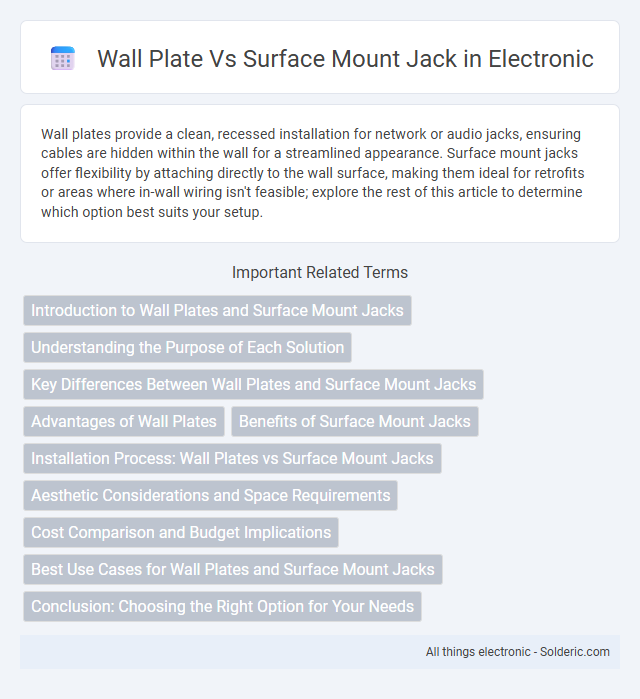Wall plates provide a clean, recessed installation for network or audio jacks, ensuring cables are hidden within the wall for a streamlined appearance. Surface mount jacks offer flexibility by attaching directly to the wall surface, making them ideal for retrofits or areas where in-wall wiring isn't feasible; explore the rest of this article to determine which option best suits your setup.
Comparison Table
| Feature | Wall Plate | Surface Mount Jack |
|---|---|---|
| Installation Location | Mounted flush on wall surface | Mounted on surface of walls or desks |
| Maintenance | Requires wall access to install or modify | Easy to access and modify |
| Appearance | Streamlined, low profile | Bulkier, protrudes from surface |
| Use Case | Permanent, clean installations | Temporary or retrofit installations |
| Durability | Protected by wall, higher durability | Exposed, prone to damage |
| Cabling | Internal wall cabling | Surface cabling visible |
Introduction to Wall Plates and Surface Mount Jacks
Wall plates and surface mount jacks serve as essential components for organizing and securing network and telephone connections in residential and commercial environments. Wall plates are typically installed flush within walls, providing a clean and streamlined appearance by housing connectors such as Ethernet, coaxial, or phone jacks. Surface mount jacks, on the other hand, are attached directly onto wall surfaces or desks, offering a flexible solution for areas where in-wall installation is impractical or impossible.
Understanding the Purpose of Each Solution
Wall plates provide a clean and organized interface for network and audio-visual connections, securely mounting jacks flush with the wall for a streamlined appearance. Surface mount jacks offer flexibility for installations where in-wall wiring is impractical, allowing connectors to be mounted directly on the wall surface, which simplifies upgrades and maintenance. Both solutions serve to facilitate structured cabling, but wall plates prioritize aesthetics and permanence, while surface mount jacks emphasize accessibility and ease of installation.
Key Differences Between Wall Plates and Surface Mount Jacks
Wall plates provide a flush, clean finish by mounting network jacks directly into the wall, optimizing space and aesthetics in structured cabling systems. Surface mount jacks are installed on the wall surface using enclosures, enabling easier access and flexibility for adding or relocating ports without drywall modifications. Wall plates are ideal for permanent wiring setups, while surface mount jacks suit temporary or modular network configurations where accessibility and adaptability are priorities.
Advantages of Wall Plates
Wall plates provide a clean, professional appearance by neatly organizing cables and connectors flush with the wall surface, enhancing both aesthetics and safety. They offer durable protection for network jacks from physical damage and dust, ensuring reliable long-term connectivity. Your installation benefits from easier cable management and simplified troubleshooting, reducing maintenance time and improving overall network performance.
Benefits of Surface Mount Jacks
Surface mount jacks offer flexible installation options on any flat surface, making them ideal for retrofit projects or spaces lacking traditional wall cavities. Their compact design reduces the need for invasive wall cutting, preserving structural integrity and simplifying upgrades. Easy accessibility and modularity enhance maintenance efficiency, supporting quick network reconfiguration or troubleshooting.
Installation Process: Wall Plates vs Surface Mount Jacks
Wall plates require recessed installation into the wall, involving cutting an appropriately sized hole and securing the plate flush with the wall surface, offering a clean and professional look ideal for structured cabling. Surface mount jacks, on the other hand, attach directly to the wall surface without the need for drywall modification, simplifying the installation process and making them suitable for retrofit applications or areas where in-wall installation isn't feasible. Your choice depends on the installation environment, desired aesthetics, and ease of access to the cabling infrastructure.
Aesthetic Considerations and Space Requirements
Wall plates offer a cleaner, more integrated aesthetic by embedding jacks flush with the wall, making them ideal for preserving room decor and minimizing visual clutter. Surface mount jacks require additional space as they protrude from the wall, which may disrupt sleek design lines but allow for easier access and installation in areas where wall cavities are unavailable. Your choice should consider both the available wall depth and desired room appearance to achieve a balance between functionality and style.
Cost Comparison and Budget Implications
Wall plates generally cost less upfront due to simpler installation within existing drywall, reducing labor expenses compared to surface mount jacks. Surface mount jacks require additional materials like mounting boxes and may involve more labor, increasing total costs. Budget considerations should include both hardware price and installation complexity to determine overall expense.
Best Use Cases for Wall Plates and Surface Mount Jacks
Wall plates are ideal for permanent installations in homes or offices where cables run inside walls, offering a clean and professional finish for Ethernet, coaxial, or HDMI connections. Surface mount jacks are best suited for retrofitting existing spaces without drywall access, allowing you to add network or audio ports externally on any flat surface. Your choice depends on whether you prioritize seamless integration (wall plates) or flexible, surface-level installations (surface mount jacks).
Conclusion: Choosing the Right Option for Your Needs
Wall plates offer a clean, flush installation ideal for permanent setups, enhancing aesthetics and cable management. Surface mount jacks provide versatility and ease of installation on various surfaces, making them suitable for retrofit or temporary solutions. Selecting the right option depends on the specific installation environment, desired appearance, and future scalability requirements.
Wall plate vs Surface mount jack Infographic

 solderic.com
solderic.com